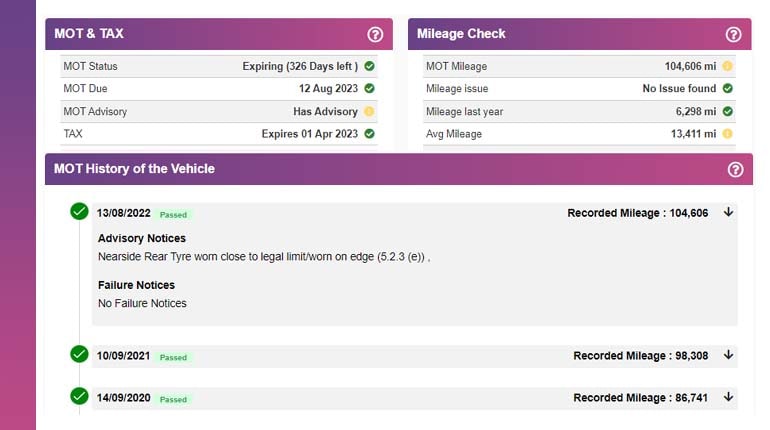MOT (Ministry of Transport) test is an annual inspection that vehicles in the UK must undergo to ensure they meet safety and environmental standards. During the MOT test, various vehicle components are assessed, and if any issues are found, they are recorded and categorized. One common term used in the MOT test report is “advisory.”
Table of contents
- 1 What is MOT advisory check?
- 2 How can I check if my car has an MOT?
- 3 What are the checks performed in a DVLA MOT test?
- 4 MOT advisory check when buying a used car
- 5 How do you get your vehicle prepared for the MOT test?
- 6 What are the MOT advisory checks?
- 7 Examples of advisory items
- 8 Importance of addressing advisory items
- 9 What are faults and advisories?
- 10 Does my car need an MOT?
- 11 Don’t ignore MOT advisories!
- 11.1 Conclusion:
- 11.2 Answering your questions
- 11.2.1 What happens if I don’t address advisory items?
- 11.2.2 What is the tyre limit for MOT advisory?
- 11.2.3 How do I know if my MOT is still valid?
- 11.2.4 How long can you drive without MOT?
- 11.2.5 What is the most common failure on MOT?
- 11.2.6 What is the 10-day rule for MOT?
- 11.2.7 What counts as a fail on MOT?
What is MOT advisory check?
An MOT advisory check is a notice given during the MOT test in the UK, highlighting issues not causing an immediate failure but requiring attention shortly to ensure vehicle safety and roadworthiness. Any vehicle will have its first MOT three years after the mandatory registration date. MOT Advisory notes are provided as part of the DVLA MOT test result. They highlight issues from the test, which are MOT-related and future component failure predictions (our reports show what is most likely to fail its next MOT).
Although the test result is Pass/Fail, the warnings or advisories given by the examiner should be addressed as they could check if your car has a fault that may affect the roadworthiness/ resale value of the vehicle.
How can I check if my car has an MOT?
To check if your car has an MOT, you can either avail of Our Free MOT History checker or check the DVLA website. It will bring up your car’s MOT history, including whether or not it has had past MOT checks and any faults found on past MOT checks.
If you want your car checked in person, you can either take it to an MOT testing station or arrange for a mobile MOT testing service to come to you.
What are the checks performed in a DVLA MOT test?
An annual inspection known as an MOT test ensures that your car meets all legal requirements for road safety and environmental protection.
As part of its MOT, every vehicle goes through inspections and tests.
If repairs are required, the testing process will take longer; the test typically lasts 45 minutes to an hour.
When inspecting your car, they’ll check for the following things:
- Brake
- Tyre
- Suspension
- Seat Belts
- Emissions range
- Headlamps & aim
View the Full DVLA MOT checklist here.
MOT advisory check when buying a used car
If you’re buying a used car and getting an MOT advisory check by performing a DVLA vehicle, The MOT history check is essential. It will help you to identify any potential problems that need to be fixed or repaired before driving your car.
In the UK, all cars must have a valid DVLA MOT certificate, so this is an essential check. If you’re buying a car from a dealer, they should be able to provide you with an MOT certificate. However, if you’re buying from a private seller/owner, you must arrange your DVLA MOT checker for UK number plates. The mot tester/examiner will conduct a series of tests on your car, including checking the brakes, tyres and lights.
They will also check for any signs of wear and tear. If any issues are found, they will be noted on the DVLA MOT certificate. These advisory checks can help you avoid buying a car that needs expensive repairs, so it’s well worth getting one done before you hand over any money. Alternatively, the current owner might agree to have the car retested as part of your purchase. When purchasing a used car in the UK, you can request the MOT certificate to tell whether the previous owner has been responsible and looked after the car.
How do you get your vehicle prepared for the MOT test?
Taking the necessary steps to guarantee that your car passes the DVLA mot checker on the first try is crucial.
Examine vulnerable areas, such as the road view, tyres, signals, and lightbulbs. Although it takes some time, it is possible to guarantee the full functionality of these components. And the test is that the vehicle must be in excellent condition.
What are the MOT advisory checks?
The test checks for potential problems, and vehicles that fail to meet the required standards will not be issued with a certificate.
Three categories of faults can be identified during an MOT:
Minor – Any issue with your car that isn’t severe enough to fail is referred to as a fault. Minor flaws may not be dangerous, but you shouldn’t disregard them. Significant flaws are still dangerous for your car and will result in a failed MOT, but they are typically less severe than dangerous flaws and may be easier and less expensive to fix. Any of the vehicle’s lights having a missing part is a typical cause of a significant fault.
Dangerous-A dangerous flaw is a defect in your car that endangers the safety of the driver, other drivers, or passers etc., The car will always fail its MOT test if it has a dangerous defect.
These vehicles should not be driven on the UK roads. In addition to these specific faults, several general advisory checks are carried out during the MOT.
These include checks on the condition of the tyres, brakes, suspension and exhaust system. Although these items are not checked for compliance with specific standards, you should be aware of any potential issues so that they can be rectified before they cause a problem.
Examples of advisory items
Advisory notices can cover various issues, including worn brake pads, minor oil leaks, corroded exhaust components, or worn tires close to their legal limit. These items are not severe enough to cause an immediate failure of the MOT test, but they are flagged to bring attention to the potential need for maintenance or repairs in the future.
Importance of addressing advisory items
While advisory items do not result in a failed MOT test, it is essential to take them seriously. Ignoring advisory notices can lead to worsening conditions or safety hazards over time. By addressing these issues promptly, you can ensure your vehicle’s longevity, safety, and reliability.
What are faults and advisories?
Faults are motoring offences that, if noticed, would immediately cause a vehicle to fail its MOT. Advisories are motoring offences that are not severe enough to fail a vehicle immediately but may do so in the future if they’re not repaired. Faults are more serious because they can cause an immediate MOT failure, while advisories are less severe because they may only fail a vehicle in the future.
Does my car need an MOT?
MOT Tests are a requirement for all cars in the UK that are more than three years old. The MOT test aims to ensure that vehicles are safe and roadworthy. When you take your car for an MOT test, the tester will visually inspect the vehicle and test its key components, such as the brakes, tyres, and lights.
The tester will then issue a pass or fail certificate, depending on whether or not the vehicle meets the MOT standards.
Don’t ignore MOT advisories!
Even though they may only be recommendations, paying attention to them is crucial even though the car has passed its mandatory MOT.
Quickly resolving advisories will stop the issue from growing and becoming more expensive.
Understanding that an MOT is the bare minimum requirement for safe vehicle operation is also critical.
Above all, regular vehicle maintenance, including addressing any advisories, will guarantee that the vehicle you are driving is as safe as it possibly can be.
Use our MOT History Checker to view the car history, including any advisories a vehicle has.
Conclusion:
In summary, an advisory notice in the context of an MOT test indicates that a vehicle component has a defect or wear that does not meet the failure criteria but requires attention shortly. It serves as a warning to the vehicle owner to monitor and address the mentioned issue to maintain the vehicle’s safety and performance. It is advisable to promptly address advisory items to prevent them from worsening and ensure your vehicle’s overall well-being.
Answering your questions
What happens if I don’t address advisory items?
Neglecting advisory items can lead to further deterioration of the component, potential safety issues, or a higher chance of future MOT test failures. Regular maintenance and timely repairs are essential for vehicle reliability and safety.
What is the tyre limit for MOT advisory?
The MOT advisory check tyre limit in the UK is 1.6mm of tread depth across the central three-quarters of the tyre, around the entire circumference.
How do I know if my MOT is still valid?
To check if your MOT is valid, visit the official UK government or The Auto Experts website and enter your vehicle’s registration number. The final report will display the current MOT status and expiration date.
How long can you drive without MOT?
Driving without a valid MOT is illegal and can result in fines up to £1,000, penalty points, and even vehicle seizure. Please don’t risk it; ensure your MOT is up to date!
What is the most common failure on MOT?
The most common failure on MOT tests is related to lighting and signalling issues, such as faulty bulbs or misaligned headlights. Regularly check your vehicle’s lights to avoid potential losses.
What is the 10-day rule for MOT?
The 10-day rule for MOT in the UK allows you to drive your vehicle to a pre-booked MOT test appointment if the current MOT has expired within the past 10 days.
What counts as a fail on MOT?
Various issues can cause an MOT test to fail in the UK, such as faulty brakes, excessive emissions, worn-out tires, defective lights, and structural corrosion.








